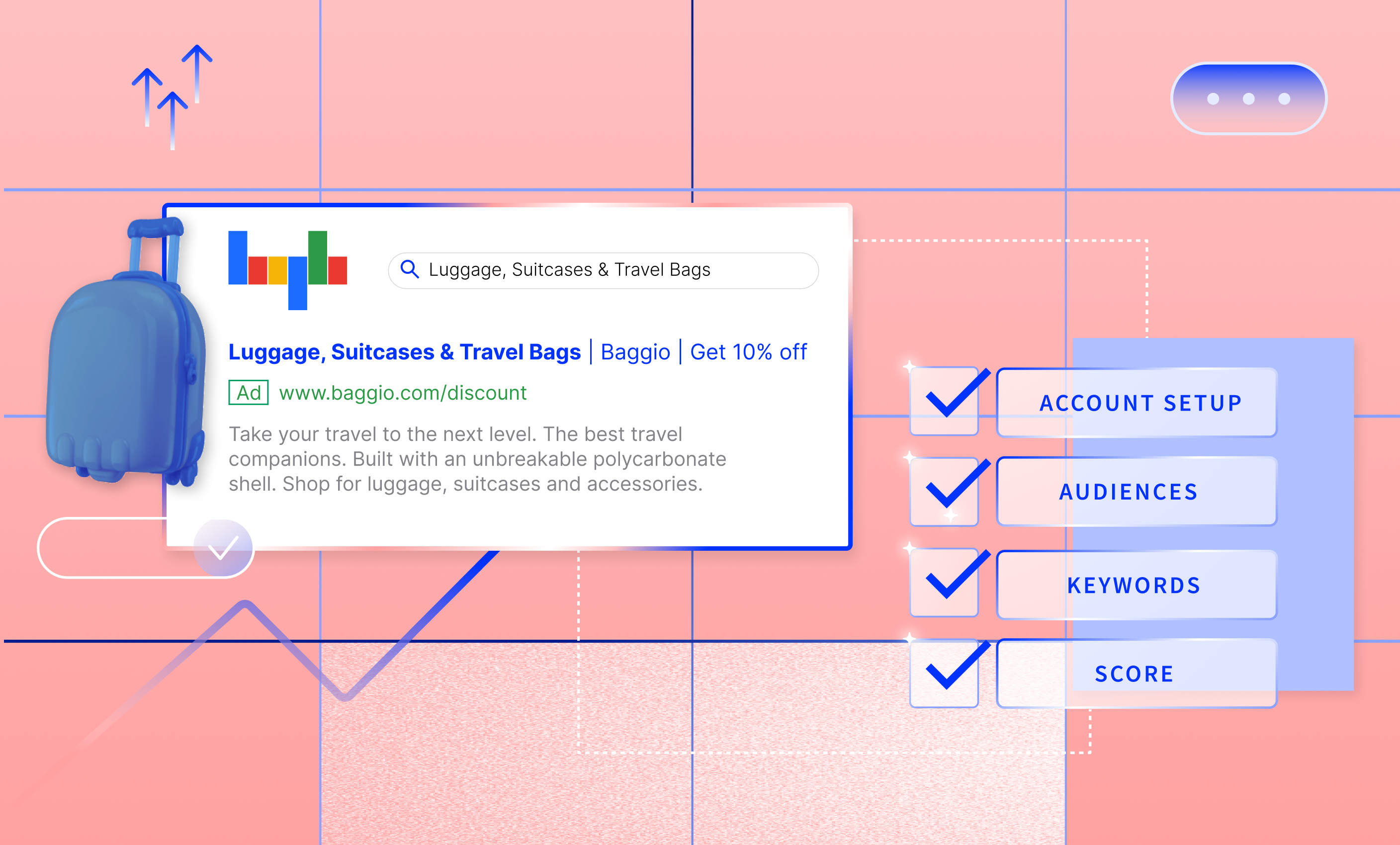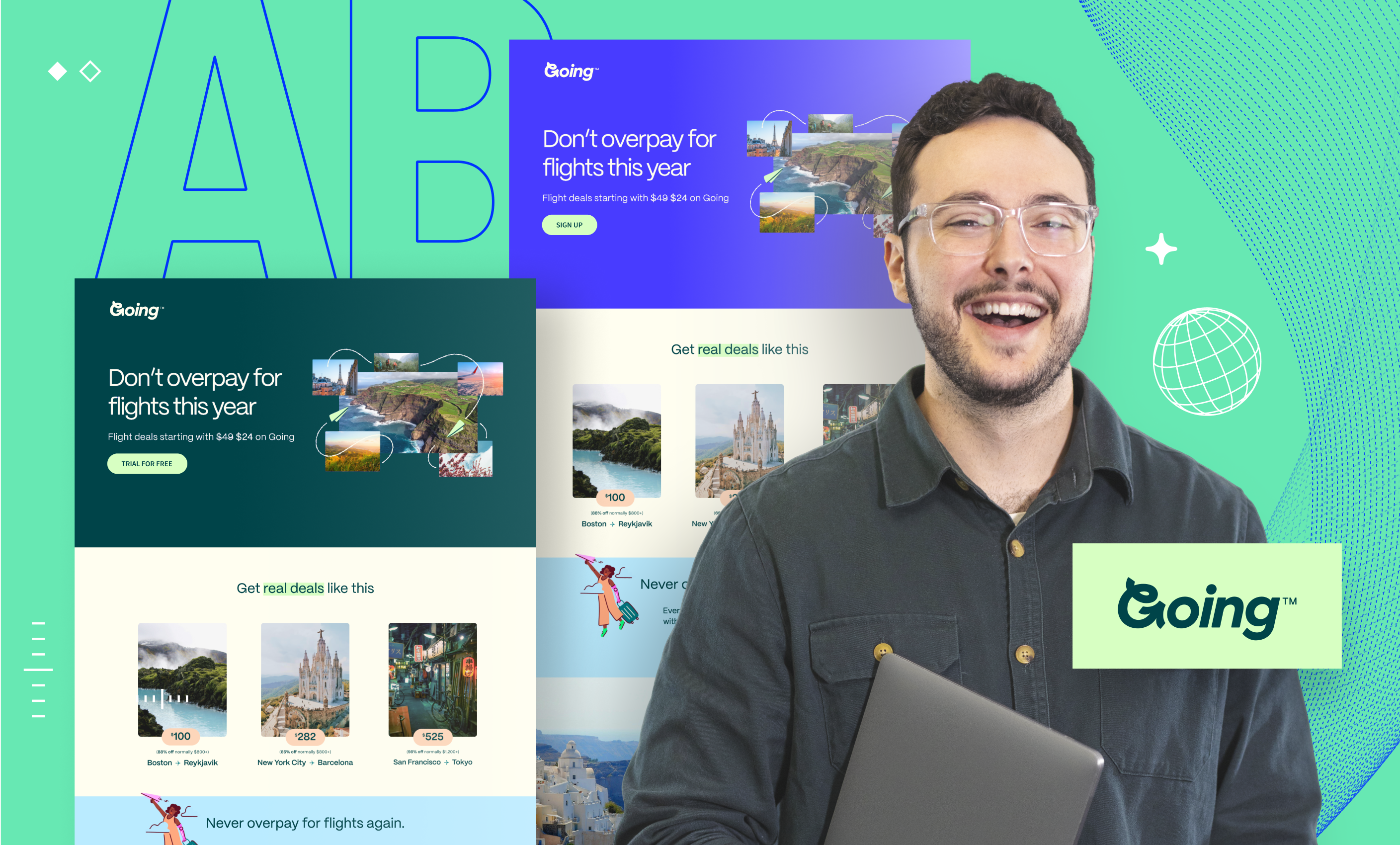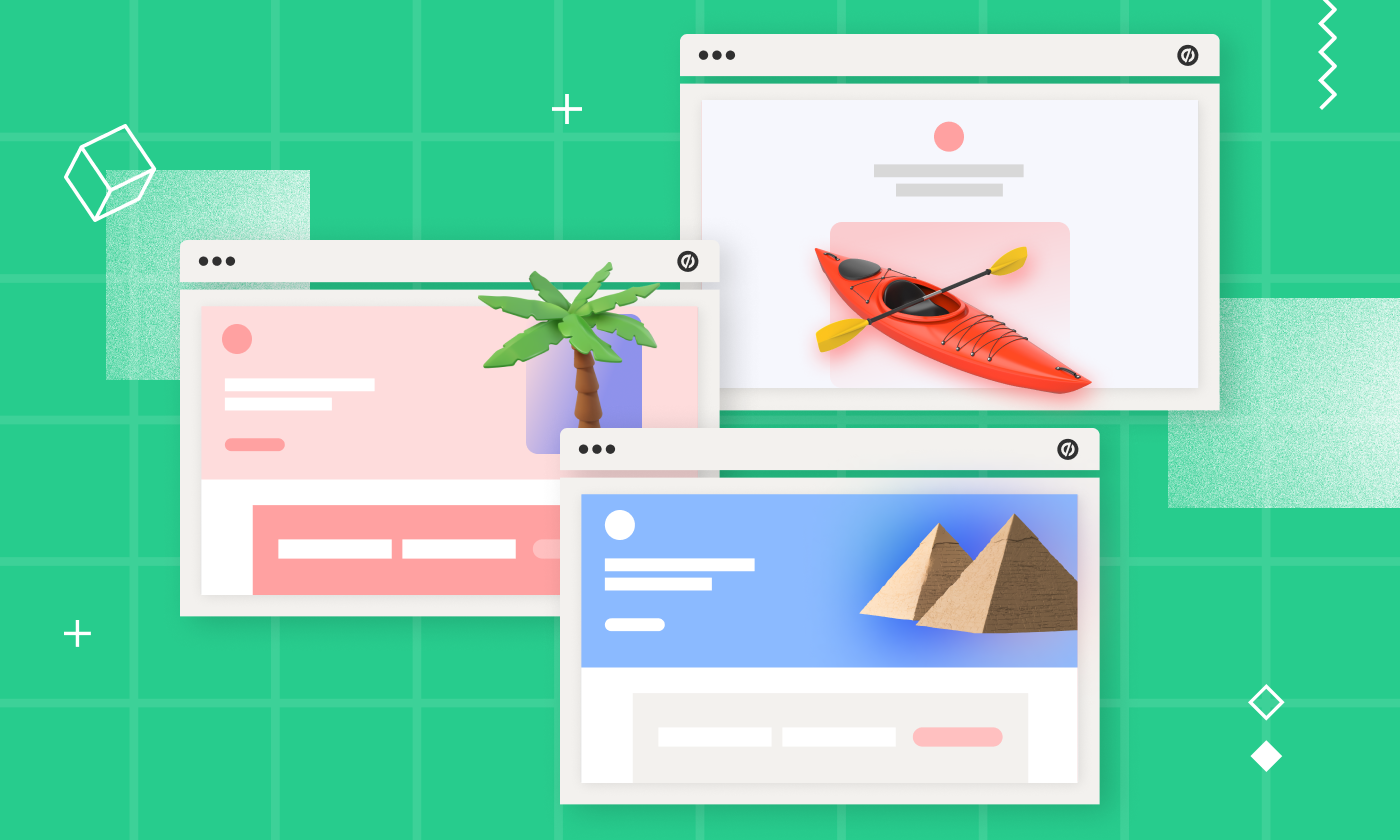What is B2B PPC?
B2B PPC, or business-to-business pay-per-click advertising, uses paid search and social ads to target potential customers online. These ads appear on platforms like Google and Facebook and help businesses connect with potential clients or users as they search for solutions the business offers. It’s one of the most powerful ways to generate leads, boost brand visibility, and drive sales in the B2B market.
Does paid search advertising work in B2B?
Done right, paid search is one of the most effective ways to market your B2B business. It allows you to get in front of your audience at the exact moment when they are looking for your solution.
Done wrong, paid search is also a great way to lose a lot of money.
In particular, it can be difficult to succeed at paid search advertising in the sorts of niche markets most B2B companies target. In many cases, the smaller your market, the harder it is to identify profitable search terms and—even when you’ve found a good keyword—turning clicks into conversions and sales can be a real challenge.
For example, one B2B company Google Ads expert Jacob Baadsgaard worked with had spent months and $150,000 on paid search advertising without producing a single sale. Is it any wonder the owner thought paid search was a waste of money?
But here’s the thing:
If you do it right, paid search can be incredibly lucrative and is actually one of the best ways to grow a B2B business.
For B2B companies in particular, paid search campaigns often succeed or fail depending on how well they understand the differences between B2B and B2C advertising.
B2B vs B2C PPC: What are the differences and why is paid advertising so effective in B2B?
Josh Gallant
Josh is the founder of Backstage SEO, an organic growth firm that helps SaaS companies capture demand. He’s a self-proclaimed spreadsheet nerd by day, volunteer soccer coach on weekends, and wannabe fantasy football expert every fall.
» More blog posts by Josh Gallant
Jacob Baadsgaard
Jacob Baadsgaard is the Founder & CEO of Disruptive Advertising, a Utah-based PPC agency that uses PPC, CRO and ROI-focused analytics to grow businesses. When Jacob’s not working, you’ll find him hanging out with his beautiful wife and three daughters or on the river fly fishing. Connect with him on Twitter or LinkedIn.
» More blog posts by Jacob Baadsgaard
To successfully market a B2B company, it’s important to understand the differences between B2B marketing and B2C marketing.
Perhaps the biggest difference between B2B and B2C is the value of a sale.
For example, the average ecommerce transaction is worth $85 to $120. Even if you factor in repeat business, you might make $250 per customer.
Assuming a 50% profit margin, your cost per acquisition (CPA) needs to be <$125 just to break even. On the other hand, the lifetime value (LTV) for B2B companies is often between $20,000 and $200,000.
For B2B companies, even with a profit margin of just 10%, you can have a CPA of over $1,000 and still produce a great return on investment.
So, how does your LTV affect your paid search campaigns? Well, the bigger your profit margin, the more room you have to figure things out.
This is important because even the best-managed campaign is rarely optimized from the get-go. A well-designed campaign will save you a lot of money during the learning curve, but truly optimized performance takes time.
If you’ve only got a $100 profit margin to work with, it can be hard to make ends meet while you get your strategy right. On the other hand, if you’ve got a $50,000 profit margin, one sale will more than cover the cost of getting your campaigns working correctly.
This gives B2B companies a huge advantage over B2C companies.
As an example, imagine a B2B company in the insurance industry starts running paid search campaigns. The company wants to generate leads for $150 or less. By thinking about their long-term profit margin ($1,000 to $10,000+), they decide to run a wide range of campaigns with different keywords to find out which ones work best.
They start with a two-week blitz to test a ton of options, and the cost per lead (CPL) is $250. But the data gathered during this time helps them find several highly profitable keywords using the ‘Keywords and Search Terms’ reports in Google Ads. Using those keywords and a great landing page strategy, they could now cut their CPL in half.
From there, the campaigns become super effective, leading to huge growth and hundreds of thousands in revenue over time.
If used right, lifetime value (LTV) can be one of the biggest advertising assets.
The best PPC channels for B2B marketers
As it stands, there’s a fairly well-established “big four” when it comes to PPC platforms B2B advertisers can use.
- Google
- YouTube
- LinkedIn
- Meta (Facebook and Instagram)
Yes, TikTok is gaining steam quickly, and yes, you can still experiment with Reddit and others like it. However, almost universally, most B2B PPC advertising budgets are spent on these four channels.
Google Ads
When you picture paid search, chances are you picture Google Ads.
While there’s more to it now, Google Ads are your traditional text-based search ads. When you Google pretty much anything and see sponsored results, those are managed through the Google Ads platform.
These are the bread-and-butter of a modern PPC strategy.
It lets you reach people who are already searching for solutions like yours by showing up directly in the search results (and at the top of the page at that if you’re budget is high enough).
Within the Google Ads platform, you can also manage display ads—mainly banner ads that appear on third-party sites—and YouTube ads, which we’ll cover in more detail shortly.
The advantages of using Google Ads in B2B are pretty clear:
- Precise targeting to reach the right audience: Google Ads allows you to zero in on specific keywords, ensuring your ads are seen by the right people.
- Scalable budgets, so you can start small and grow: Whether you’re a small business or a large corporation, you can adjust your ad spend as you see results.
- Data-driven decisions from detailed analytics: With Google Analytics, you get the data you need to make informed choices and constantly improve your campaigns.
- High intent leads who are ready to buy: People using Google often look to make a purchase, leading to higher conversion rates.
- Customizable ads that hit specific pain points: Tailor your ads to address your audience’s exact problems, making them more likely to engage and convert.
YouTube Ads
While they’re technically managed through the Google Ads platform, YouTube ads at this stage of the game are worthy of their own section.
YouTube had 1.3 trillion visits in 2023 (that’s right, trillion with a ‘T’, as in 1,300,000,000,000 visits). It’s the second largest search engine in the world, behind only Google itself and ahead of others like Bing and Yahoo.
The interesting dynamic with YouTube is that it falls somewhere in the middle between Google and social channels like Facebook or TikTok on the “intent” scale. It’s a one-part search engine, one-part social network. Because of this, you can run YouTube ads that target specific search terms to tap into the “search engine” side, or you can run ads targeting certain audiences more broadly as they’re watching videos, tapping into the “social network” side.
Both approaches can work when deployed properly.
- Search term ads can target high-intent keywords to meet your audience just as they’re actively looking for what you can help with, similar to Google search ads.
- General video ads or pre-roll ads can target high-value audiences even when they aren’t actively looking for what you do to help build brand affinity and mindshare, similar to how you would run a typical Facebook or TikTok ad campaign.
Overall, the advantages of running YouTube ads are pretty clear as well:
- Massive reach: With billions of visits every month, your ads can reach a massive audience when delivered effectively.
- Engaging format: Video content is generally more engaging and memorable compared to text or image ads.
- Targeting capabilities: You can target your ads based on demographics, interests, and behaviors, ensuring they reach the right audience.
- Cost-effective: While there’s some nuance to it, you typically only pay when someone watches your ad, making it a cost-effective option for reaching a large audience.
- Analytics and insights: YouTube provides detailed analytics, helping you understand how your ads are performing and how to optimize them.
LinkedIn Ads
LinkedIn is generally the go-to platform for B2B marketing given its skew toward professionals and “work mode” interactions. Their ads platform allows you to target ads based on job titles, industries, company size, and more. LinkedIn Ads are ideal for generating high-quality leads and reaching senior-level decision-makers.
Be mindful though that because of how granular you can get with your targeting, LinkedIn ads typically come at a much higher CPM—or cost to reach 1,000 users—than other platforms.
Still, for B2B in particular, there are some big advantages to using LinkedIn:
- Precise work-oriented targeting: You can precisely target professionals and decision-makers with your ads.
- B2B lead generation focus: LinkedIn ads are effective for B2B lead generation campaigns.
- Direct message ads: You can send Message Ads that land directly in a user’s inbox, ensuring high visibility.
- Advanced company and career analytics: Advanced analytics let you optimize your campaigns and improve results.
- Professional audience network: LinkedIn’s professional audience network helps enhance the quality of your leads and connections.
Meta Ads
Meta Ads includes Facebook and Instagram ads primarily. You can also manage ads on third-party websites or mobile apps as well, but in B2B especially, you’ll almost exclusively be focused on the “in platform” ads.
Why run Facebook and Instagram ads?
First and foremost—audience size. Facebook has a reported 3 billion users, and Instagram has a reported 2 billion users. No matter what industry you’re in, your audience is on one of these platforms (and likely both). The challenge is how you can narrow down that number to only reach the people you want to reach, but that’s a topic we’ll cover later on in this post when we talk strategies and best practices.
You have multiple ad formats at your disposal here too as opposed to just standard text-based ads like in Google search:
- Image ads: Great for eye-catching visuals and concise messages.
- Video ads: Perfect for showcasing product demos, customer testimonials, and brand stories.
- Carousel ads: Allow you to display multiple images or videos in a single ad, ideal for highlighting different features or services.
- Lead ads: Simplify the process of capturing lead information directly within the ad.
The advantages of using Meta Ads in B2B are pretty compelling:
- Precise targeting options: Meta’s advanced targeting features let you pinpoint your audience based on demographics, job titles, industries, interests, and specific actions they’ve taken on your website if you have the proper tracking in place.
- Cost-effective campaigns: You can start with a small budget and adjust your spending based on performance, making it accessible for businesses of all sizes.
- High engagement rates: Both Facebook and Instagram have high user engagement, which means your ads are more likely to be seen and interacted with.
- Visual storytelling: Instagram allows you to tell your brand’s story through high-quality images and videos, making your content more memorable.
- Audience insights: Meta provides detailed analytics and audience insights, helping you refine your campaigns and target more effectively.
Other channels to experiment with
Exploring additional channels beyond the “big four” we’ve already covered can help you tap into new audiences and diversify your B2B marketing strategy. Here are some other platforms worth experimenting with:
TikTok might seem like an unconventional choice for B2B marketing, but its popularity and vertical video format can still work in B2B with the right strategy in place.
With TikTok, you can create engaging short videos that showcase your brand’s personality and creativity, and you can easily partner with established creators on the platform. It’s particularly useful for reaching younger professionals and making your brand stand out in a fun and memorable way.
- High engagement with short, entertaining videos
- Potential to go viral and reach a broad audience
- Creative ad formats like In-Feed Ads, Branded Hashtags, and Branded Effects
Reddit is more of an experimental channel for B2B marketing. While it offers unique opportunities to engage with niche communities, it’s not a platform to invest heavily in right off the bat. You’ve likely seen a few memes floating around about brands that advertise too aggressively on Reddit.
The TL;DR version is this: Reddit users can be ruthless.
Still, by running targeted ads in relevant subreddits, you can reach users who are already discussing topics related to your industry. Reddit can be a good place to drive traffic and tap into communities of link-minded individuals, but it should be used to complement your primary marketing efforts.
- Access to niche and highly engaged communities
- Opportunities for organic engagement through comments and discussions
Bing Ads, now known as Microsoft Advertising, can be a valuable addition to your PPC strategy. Even though Google is still the dominant player in the search space, Bing has a significant user base, particularly among older professionals.
Ads on Bing can help you reach an audience that may not be as active on Google, providing a broader reach for your campaigns. Think of Bing ads as coloring in the potential white spaces that are left behind if you were only advertising on Google.
- Lower competition compared to Google Ads
- High visibility on default search engine for Microsoft products
- Integration with Microsoft’s AI tools for better targeting
Effective B2B PPC strategies and best practices
Before we dive head first into the step-by-step process you can follow to build high-performing PPC campaigns, let’s establish a few baseline best practices. Without these three concepts in place, the rest won’t matter anyway.
Identify your audience
Often, who you think you’re targeting isn’t always who you’re actually targeting.
Unlike B2C companies — which are usually familiar enough with their audience that they know which keywords will produce results even before they start advertising — it can be difficult for B2B companies to find the right keywords for their niche.
After all, in a niche market, it can be hard to predict which keywords your audience uses when they are looking for your product or service.
In an effort to try and get in front of the right audience, many B2B companies bid on search terms that are superficially related to their offering but don’t actually indicate any relevant search intent.
Unfortunately, the wrong keywords drive the wrong traffic… and the wrong traffic never converts.
For example, remember that B2B company we mentioned earlier? The one that wasted $150,000 on paid search?
Well, $60,000 of their ad spend went towards search terms related to the keyword “translate” — which averages more than 150 million searches per month.
That’s a lot of potential traffic, right? The problem is, most of the time, the more searches there are for a keyword, the less specific the search intent is.
And, if the search intent isn’t very specific, most of your traffic probably isn’t a good match for your landing page.
In this company’s case, none of the traffic was a match
Not surprisingly, most searches that include keywords like “translate” don’t indicate a strong interest in a B2B company.
As a result, they got a lot of clicks, but their traffic wasn’t interested in their product, so no one ever converted.
Less is more
On the other hand, here’s what happens when you identify the specific keywords that your customers are using a real example from one of Jacob Baadsgaard PPC clients:
If you notice, click volume quickly falls off while conversions are about the same. Eliminate irrelevant clicks, and you eliminate their associated cost.
That frees up a lot of budget you can use to identify additional relevant terms and build your traffic volume back up—only this time, that traffic comes with more conversions. And, all of a sudden, paid search makes a lot more sense.
In this particular case, the company ended up spending 48% more than when they started with Jacob’s team but produced 9x more leads.
Speak to the pain point
In addition to targeting the wrong audience, many B2B businesses struggle to communicate their message effectively.
A lot of businesses assume that everyone cares about the specifics of their offering. After all, they put a lot of work into all those features.
The problem is most people aren’t looking for a list of features — they are looking for solutions. Your target audience doesn’t click on your ad because they want to know about your product. They click because they think you can solve their problem.
To convert people, you need to identify the problem that triggered their search and address that pain point directly in your ad and landing page. Unfortunately, many companies think their landing page must address every possible question or scenario.
Your sales team’s job is to highlight your product’s features. The goal of a landing page is to show how your offer solves their problem.
If your ads are properly targeted, 90% of your traffic will come to your page with some version of the same pain point in mind. A landing page that speaks to that pain point will win their business.
How to build and launch a successful B2B PPC campaign
So you know where most of the PPC action is happening, how you should be thinking about PPC in general from a B2B perspective, and a few of the best practices for understanding and speaking to your audience.
The big question now is this:
How do you actually run a winning B2B PPC campaign?
In this section, we’ll break the process down into seven straightforward steps that’ll carry you from brainstorming objectives all the way through to A/B testing all of the individual components within your campaigns.
Step 1: Define clear campaign objectives
Start by identifying your business goals. Are you looking to generate leads, increase brand awareness, or drive sales? Setting clear, specific goals helps you measure success.
Use SMART objectives as well that are specific, measurable, attainable, relevant, and time-bound. Determine the key performance indicators (KPIs) that will help you track your progress. Knowing what you want to achieve and how to measure it is crucial for a successful campaign.
Step 2: Conduct audience research
Before diving into keywords and campaign creation, you need to understand who you’re trying to reach.
Define your target audience by considering job titles, industries, company sizes, and pain points. Create detailed buyer personas to guide your targeting and messaging. Use tools like LinkedIn and industry reports to gather insights about your audience.
Step 3: Conduct in-depth keyword research
Keyword research is the foundation of a great PPC campaign.
Use tools like Google Keyword Planner or other premium tools like Ahrefs or Semrush to figure out what your target audience is likely searching for, and which of those searches may make the most sense for you to target with ads.
When you’re just starting, focus on long-tail keywords—more granular and specific searches than broad queries—as they’re often less competitive and more specific to your niche. Don’t forget to analyze competitor keywords to find opportunities and gaps. Then, group your keywords into relevant ad groups to keep your targeting and ad copy focused and effective.
Step 4: Create effective post-click landing pages
Landing pages can make or break your campaigns.
You could build the perfect PPC campaign with perfectly optimized campaign settings, bid strategies, targeting, and ad copy and still drive a flat $0 in return on your ad spend if the landing page you send visitors is poor and can’t convert.
We always recommend following conversion-centered design principles to build PPC landing pages that capture attention immediately and carry visitors toward a conversion.
A few simple landing page best practices for PPC campaigns in particular:
- Your landing page should match the promise of your ad. We call this message matching. For example, if someone clicks on an ad for a free trial, the landing page should be all about that trial.
- Make sure your landing page loads quickly and is easy to navigate. Slow-to-load, confusing landing pages are a one-way ticket to the back button. Use clear headlines, concise copy, and strong CTAs to guide visitors toward the desired action.
- Keep the design clean and focused, with as few distractions as possible that could prevent visitors from converting.
If you want to see a real-world example of a company using PPC landing pages to get results, check out how Later generated 100,000 leads with content and landing pages. And if you’re in the market for some inspiration, start with our roundup of the best B2B landing page examples.
Step 5: Write compelling ad copy
Knowing where you want to show up with an ad is still only half the battle. To actually win the click, you need an ad copy that captures attention and is compelling enough to get users to click through to your landing pages.
Your ad copy needs to be clear, concise, and engaging, and should highlight what makes your product or service unique and include a strong call to action. Always aim to speak directly to your target audience’s pain points and how you can solve them as well.
You don’t need to start from scratch.
For Unbounce users, you can use Smart Copy, our AI copywriting tool, to instantly generate optimized ad copy with AI. With Smart Copy, you can also use our handy URL to ads tool that can generate ad copy for you by simply scanning your landing page.
This way you don’t have to stare at a blank Google Doc wondering what you should experiment with. Instead, you can go from zero to one with AI, then tweak the outputs to match your brand.
Step 6: Set up tracking and analytics
What gets measured, gets managed.
The only way to improve your PPC campaigns over time is to actually be able to explore what’s working and what isn’t. Yes, the platforms will give you their interpretation of “success” in your campaign analytics. Still, you must have properly established what a conversion is for you and what you’re optimizing for. Otherwise, Google Ads may tell you an ad set has generated 100’s of conversions, when it’s actually looking at a completely wrong metric.
Use this quick audit checklist to make sure you have the basics covered:
- You have conversion events setup in your ad platforms.
- You have Google Analytics (or an alternative) in place on your landing pages.
- You have conversion event tracking configured in your Google Analytics.
- You’ve tested your landing page form or funnel in an incognito window, and each analytics platform you use is properly logging the events.
Step 7: Launch, monitor, optimize, and constantly A/B test your campaigns
The job doesn’t end when you press publish.
In order to maintain a successful PPC campaign and improve upon the results over time, you need to monitor the data you’re collecting and constantly be looking to optimize your ads, your targeting, and your landing pages.
- Review keyword and search term reports in Google Ads to catch irrelevant terms and add them as negative keywords in your account.
- Monitor key metrics like click-through rate, cost-per-click, and conversion rate at the campaign, ad set, and ad levels to monitor what’s working best.
- Continuously A/B test different elements—ad copy, keywords, landing pages—to find what messaging, creative, and layout works best.
- Based on your performance data, adjust your bids, budgets, and targeting to maximize your ROI.
Keep tweaking and optimizing to ensure your campaigns stay effective and efficient. The mantra is simple:
To put our money where our mouth is, we recently hosted a webinar to share how Unbounce improved paid search CAC by over 50% with a few advanced conversion rate optimization strategies.
10 metrics to track to measure your B2B PPC campaigns
The list of PPC metrics you can measure is essentially endless—and we’ve written about it in depth in the past—but remember:
Just because you can do something doesn’t mean you should.
Yes, it’s possible to measure a million different things that all connect to your PPC campaigns, but that’ll be a one-way ticket to overwhelm town for you. You’ll drown in numbers and dimensions and segments before you get a chance to actually take action.
Instead, start with these 10 metrics and layer on more as you go, depending on the types of campaigns you run.
- Click-through rate (CTR): Measures the percentage of people who click on your ad after seeing it, indicating ad effectiveness and engagement.
- Cost per click (CPC): Tells you how much you’re paying for each click, helping you manage and optimize your budget.
- Conversion rate (CVR): Shows the percentage of clicks that result in a desired action, such as a purchase or sign-up, indicating the effectiveness of your ads in driving conversions.
- Cost per acquisition (CPA): Measures the cost of acquiring a new customer, helping you understand and optimize your ad spend efficiency.
- Impressions: Indicates how many times your ad is shown, helping you assess the reach and visibility of your campaigns.
- Conversion value: Represents the total monetary worth of all your conversions, providing insights into the quality and financial impact of your leads.
- Return on ad spend (ROAS): Measures revenue generated from your ads compared to the amount spent, helping you gauge the profitability of your campaigns.
- Bounce rate: Shows the percentage of visitors who leave your landing page without interacting, indicating potential issues with your landing page relevance or user experience.
- Ad spend: Tracks the total amount spent on your ad campaigns, helping you manage your budget and measure cost efficiency.
- Quality score: A rating in Google Ads that reflects the relevance and performance of your ads, keywords, and landing pages, influencing your ad position and cost.
If all you measure are these 10 metrics, you’ll have a great idea as to what is and isn’t working within your campaigns—especially when you compare certain ad sets, ad copy, ad creative, audiences, or landing pages against each other using these metrics.
Common mistakes to avoid with your B2B PPC campaigns
As with all things in marketing, there are plenty of common mistakes that are easy traps to fall into. That said, time and time again we see the same three mistakes popping up.
Sending ad visitors to the homepage
One far-too-common mistake is directing ad traffic to the homepage instead of a tailored PPC landing page. Your homepage is often too general and not focused on your ad’s specific offer or message.
Build dedicated landing pages for each PPC campaign. Make sure these pages are aligned with your ad copy and offer a clear path to conversion. Use compelling headlines, concise content, and strong calls to action that resonate with your audience’s intent. This improves user experience and significantly increases the chances of conversion.
Ignoring landing page optimization
Another major mistake B2B marketers make is neglecting their landing pages and treating them as a box to be checked.
Yes, it’s better to point your ads to a dedicated landing page rather than your homepage, but that landing page still needs to be optimized to convert visitors into leads. A poorly optimized landing page can tank your conversion rates even if your ads are top-notch.
Make sure your landing pages are relevant, load quickly, and have clear calls-to-action. If visitors land on a page that doesn’t meet their expectations or is difficult to navigate, they’ll bounce right outta there, and your ad spend will be wasted.
One thing to keep in mind as well:
Paid media optimization is a constant process.
To make sure you never miss an opportunity to optimize, we recommend using a platform that has both a landing page builder and built-in A/B testing so you can easily build pages, create variants, and A/B test in one place.
Failing to continuously optimize campaigns
B2B marketers often set up their PPC campaigns and call it a day, leaving them running in the background without any regular reviews and optimizations. The digital landscape changes rapidly, and what works today might not work tomorrow.
Regularly analyze your campaign data, adjust your keywords, ad copy, and bids based on performance, and stay updated with new PPC trends. Continuous optimization is key to maintaining and improving your campaign’s effectiveness.
One simple approach to take here:
Implement a routine review process for your campaigns to monitor key campaign health metrics and overall performance. Put it in your calendar too. Schedule regular check-ins to analyze performance metrics and make necessary adjustments.












![[Build – MOFU] PPC Use Case Page – V2 Landing pages with PPC](https://unbounce.com/photos/blog-visual-cta-generic-ppc-yellow.jpg)









